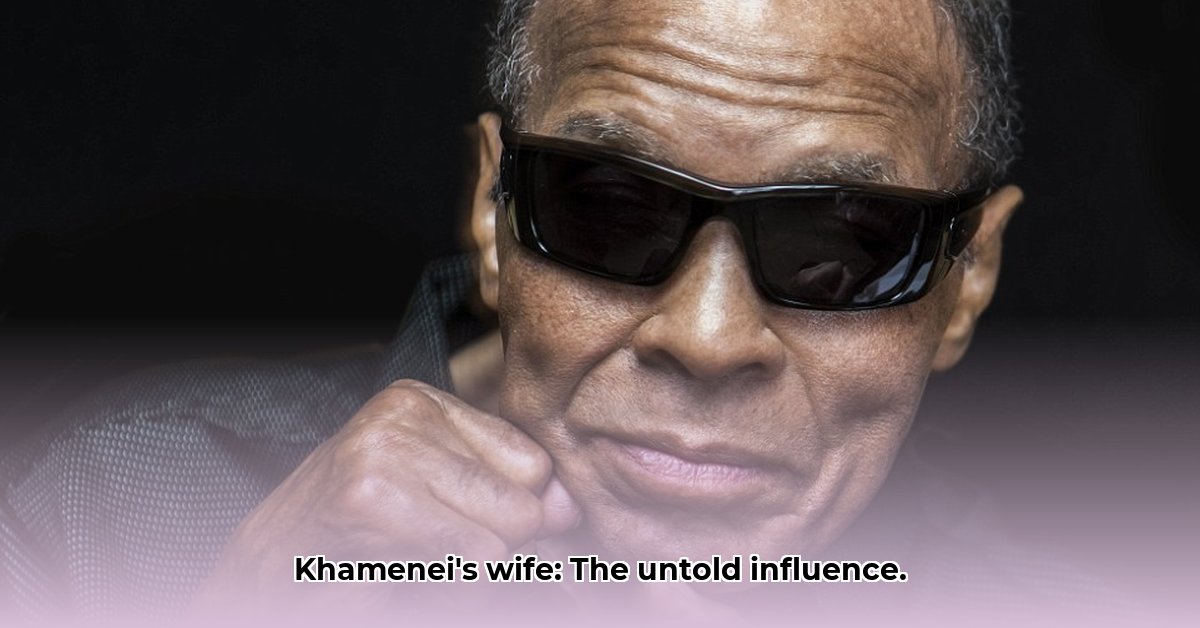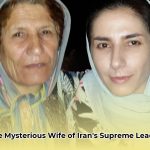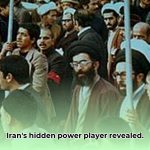Ever wondered about the woman behind one of the world’s most powerful men? Mansoureh Khojasteh Bagherzadeh, wife of Iran’s Supreme Leader Ali Khamenei, is a figure shrouded in mystery. For more details on her life, check out this biography. While she rarely appears in the public eye, her family connections and background suggest a significant, though unseen, influence on Iranian politics. This article explores what is known about her life, what can be reasonably inferred, and what remains frustratingly out of reach. We’ll examine her family history, her early life, her marriage, and how these factors might connect to the complex dynamics of power in Iran. It’s a journey into a world of careful analysis and limited information, revealing a fascinating, albeit partly hidden, story.
Ali Khamenei Wife Mansoureh Khojasteh: A Portrait in Shadows
Mansoureh Khojasteh Bagherzadeh. The name evokes a sense of enigma. She’s the wife of Iran’s Supreme Leader, Ali Khamenei, a woman whose life is largely a puzzle with only a few publicly available pieces. While a complete understanding of her influence may remain elusive, piecing together the known fragments reveals a compelling, albeit incomplete, picture. Let’s delve into this intriguing topic, exploring Khamenei’s family life and the influence of women in Iranian politics.
Unveiling the Known: A Glimpse into Her Life
What is definitively known about Mansoureh Khojasteh? Surprisingly little beyond the basics. Born in 1947 in Mashhad, Iran, a city revered in Shia Islam, she comes from a religious family. Her father, Mohammad Esmaeil Khojasteh Bagherzadeh, was a businessman. She married Ali Khamenei in 1964. Together, they raised six children: four sons and two daughters. Beyond these foundational details, documented information becomes scant. Details about her education, personal interests, or daily routines are largely unavailable, prompting questions about the reasons behind this lack of information. Is it a deliberate strategy to protect the privacy of the Supreme Leader’s family? Or does it align with cultural norms emphasizing discretion? The answer likely resides in a combination of these factors. The limited information fuels further curiosity about the Khamenei family history and the role of women in Iran.
Family Connections: A Web of Influence?
Mansoureh’s family background adds another layer to the intrigue. Her brother, Hassan Khojasteh Bagherzadeh, previously served as the deputy director of the Islamic Republic of Iran Broadcasting (IRIB), a powerful state-controlled media organization. This connection suggests established ties within the Iranian establishment. Did these connections shape her life, perspectives, or even her husband’s decisions? While definitive answers are elusive, the potential for influence exists. Some analysts propose that her family’s social and economic standing likely afforded her certain advantages and a unique perspective on Iranian society. Others caution against drawing direct causal links between her family’s positions and specific political outcomes. The reality is likely a complex interplay of family connections, personal choices, and the dynamics of the Iranian political system. These ties underscore the importance of family influence in politics and Iranian elite connections.
Marriage to Khamenei: A Union Forged in Revolution
Mansoureh Khojasteh met Ali Khamenei during a private ceremony in 1964, solidifying a bond that would intertwine with the destiny of Iran. Their marriage, officiated by Ayatollah Mohammad Hadi Milani, marked the beginning of a journey through the tumultuous years of the Iranian Revolution and the subsequent establishment of the Islamic Republic. The early years of their marriage were marked by financial constraints and political activism. As Ali Khamenei rose through the ranks of the revolutionary movement, Mansoureh played a supportive role, managing the household and raising their children amid the challenges of underground political activities.
The Challenges of Research: Navigating a Wall of Silence
Researching Mansoureh Khojasteh presents significant obstacles. Official sources provide minimal information about her. Open-source intelligence efforts yield limited results. Even seemingly mundane details prove elusive. The Iranian government’s strict control over information and its emphasis on privacy amplify the difficulty. This deliberate lack of transparency deepens the mystery surrounding this woman at the center of Iranian power. The challenges in researching her life highlight Iranian government secrecy and the limits of open-source intelligence.
Influence and Impact: A Question Mark Remains
Did Mansoureh Khojasteh exert significant influence? The answer likely isn’t a straightforward yes or no. Any influence she wielded was likely indirect and subtle, operating behind the scenes. As a wife and mother within a prominent family, her actions would primarily occur outside the public sphere. Direct involvement in political decisions would likely be discreet and carefully concealed. However, dismissing the potential impact of her position entirely would be imprudent. Simply belonging to the Supreme Leader’s inner circle grants a degree of influence, even if unspoken and unseen. She may have provided counsel, offered alternative perspectives, or served as a source of support for one of the world’s most powerful leaders. The extent of her influence, however, remains largely speculative. Hidden power dynamics and behind-the-scenes influence are crucial concepts to consider.
Potential Avenues for Future Research: Unraveling the Enigma
Future investigations could explore several avenues to gain further insight. Researchers could delve deeper into the Khamenei family’s economic activities, exploring potential links between their business interests and government policies. A more comprehensive analysis of the family’s social networks could also reveal subtle yet significant connections and influences. Examining historical accounts, memoirs, and testimonies from individuals with close ties to the Khamenei family might provide valuable information. However, it’s imperative that future investigations account for potential biases in data, ensuring a balanced and nuanced interpretation. Accessing information about Khamenei family business and Iranian social networks could provide deeper understanding.
Ultimately, increased transparency from the Iranian government is essential for a comprehensive understanding of Mansoureh Khojasteh’s life and potential influence.
The Silent Power Broker: A Concluding Thought
Mansoureh Khojasteh Bagherzadeh embodies a captivating paradox: a private individual in a profoundly public position. While definitive conclusions remain elusive due to the dearth of available information, the very mystery surrounding her speaks volumes. Her life remains an intriguing enigma, a testament to the complexities of power and privacy in a world where even the most seemingly ordinary women can wield extraordinary sway. The puzzle, though incomplete, provokes compelling questions, and future research may yet unveil the true extent of her influence. The influence of private individuals in politics is a concept that continues to fascinate.
How Did Mansoureh Khojasteh Bagherzadeh Influence Iranian Politics?
Key Takeaways:
- Mansoureh Khojasteh Bagherzadeh’s direct political influence remains largely unverified.
- Her family background, marriage to a key figure, and support during pivotal moments offer insights into potential indirect influence.
- The secrecy surrounding her life makes definitive conclusions difficult.
- Her role as a wife and mother within a powerful political family necessitates careful consideration.
- Further research is needed to fully understand her role in Iranian society.
A Life Shrouded in Secrecy
Mansoureh Khojasteh Bagherzadeh, wife of Supreme Leader Ali Khamenei, has largely remained out of the public eye. Understanding her life is crucial to grasping the dynamics of Iranian power. How did she, a private citizen, potentially impact the nation’s political landscape? This is a question that demands careful consideration. Thinking about the questions of influence in politics and the impact of women in power, how did her role as a wife play into her actions?
Family Ties and Indirect Influence
Born in 1947 in Mashhad, her family background is significant. Her father’s business dealings and her brother’s position within IRIB (Islamic Republic of Iran Broadcasting) provide crucial context. These connections could have provided access to information and networks influential within the Iranian political system. Does this automatically translate into direct influence for her? Not necessarily. But it suggests pathways to indirect power. Think of it like a ripple effect: a small stone dropped in a still pond creates expanding circles. Family ties in politics and indirect influence strategies could be linked here.
The Weight of Support
Mansoureh’s unwavering support for her husband during his political ascent and imprisonment is notable. Accounts suggest that she provided him with support and a stable home life. This steadfast loyalty during difficult times speaks volumes about her character and could have solidified her position within her husband’s inner circle. Was this merely personal support? Or did her quiet strength serve a larger purpose, subtly shaping events from behind the scenes? That remains a point of speculation. The impact of spousal support and behind-the-scenes political influence remains a question.
The Challenge of Unseen Influence
The very nature of her life complicates the analysis of how did Mansoureh Khojasteh Bagherzadeh influence Iranian politics. She’s largely absent from public life, rendering direct evidence of political maneuvering scarce. This lack of transparency, characteristic of the Iranian political system, inhibits clear assessment of her impact. The topic of unseen influence and the role of transparency in governance comes up again.
A Wife’s Role in a Theocracy
Mansoureh’s position as the wife of the Supreme Leader is not to be underestimated. To what extent did she serve as an advisor,













